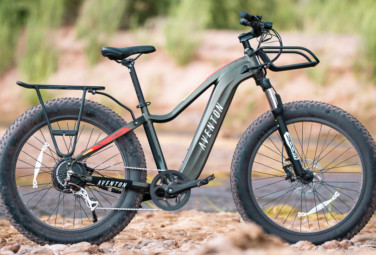

The Himiway Cruiser comes in at $1,399, a full $200 less than the RadRover 5 at $1,599 – plus you get the rear rack. In fact, Rad Power Bikes most recently increased the price to $1,599 from $1,499. Rad’s been known for building affordable, quality ebikes, so it’s a little bit of a surprise that they lost out on price. Some other similarities include twist-grip throttles, and both have main-battery powered head and tail lights. And both bikes use Tektro Airies 180mm mechanical disc brakes. The RadRover does come in a little lighter, at 69 pounds versus 72 for the Himiway Cruiser. Weight ratings on ebikes are tricky since you don’t necessarily know how much effort goes into determining them. The Himiway Cruiser has a much larger payload capacity, 350 pounds vs RadRover 5’s 275 though it’s hard to know for sure if Rad is under-promising and over-delivering. Get a closer look at the rear rack in this YouTube video. You’ll have to fork over $79 for the RadRover rear rack, which admittedly is very well built. Both come with front and rear fenders, but the Himiway comes with a rear rack ready to go (with a wood grained panel on top, and interesting choice for a fat bike). There are a few other comparisons to look at in our look at Himiway vs Rad. It too can be overridden in settings to reach speeds of around 23 mph. The RadRover is a Class 2 ebike, coming from the factory limited to this 20 mph with either pedaling or using the twist throttle (or both). The RadRover by contrast can hit 20 miles per hour on a flat or even going up small hills. Make sure you follow local bike laws if you do this since many places have limits on how fast you can travel on an ebike. Out of the box, the Himiway Cruiser can hit top speeds up to 22-23 miles per hour, but you can actually tinker with the settings to allow up to 28 miles per hour speeds. Although Shimano components tend to be good, for example, there is a wide range in its product lines and knowing the specific model is important for comparison purposes. Neither bikes really seem to have much of an advantage but it’s odd the Himiway doesn’t offer more specifics about its components. This also helps prevent getting your pants dirty while riding.Īnd both bikes come with a front shock fork (Rad’s an is RST, Himiway’s doesn’t specify), and Kenda 26×4″ fat bike tires. Rad and Himiway both have dual guards around the front ring to protect against dirt and muck clogging up your gears. Gearing, shocks and componentsīoth have a seven speed cog in back with Shimano derailleur (RadRover’s is Acera, Himiway has Shimano Atlus shifters) and a single-speed crank front. The RadRover 5 only gets an estimated 25 – 45 miles on its charge with its 14 Ah (640 Wh), which means less time out on the single track or plowing through the snow on your way to work. Both feature a 750 w gear hub drive motor with 80 nm of torque, plenty to haul either of these fat bikes over the roughest of terrain.īoth batteries are 48V packs sporting Samsung cells, but the Himiway Cruiser’s battery has a 17.5 Ah (840 Wh) battery, allowing it an estimated 35 (full electric) – 60 miles (lowest pedal assist) on a single charge.

The motor is one area the two bikes are basically identical. They’re less identical than first glance would have you think. And the high-rise handlebar set up, along with bottom tube battery mount, makes the two look like very similar bikes.īut there are definitely some differences between the two bikes, when you take a close look at the specs of the Himiway vs Rad. Both have an almost identical frame style, with a slight bend in the top tube near the seat side. Upon first glance, if you saw the Himiway Cruiser and the RadRover 5 side by side, you wouldn’t be looked down upon if you mistook them for the same bike.


 0 kommentar(er)
0 kommentar(er)
